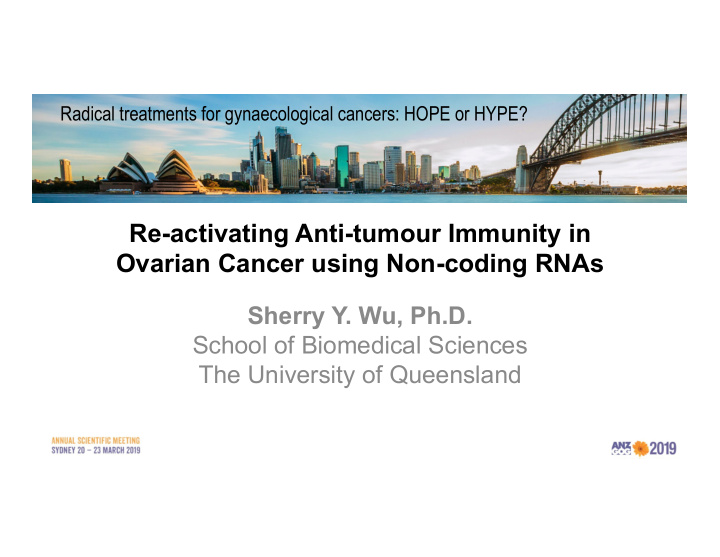



Radical treatments for gynaecological cancers: HOPE or HYPE? Re-activating Anti-tumour Immunity in Ovarian Cancer using Non-coding RNAs Sherry Y. Wu, Ph.D. School of Biomedical Sciences The University of Queensland
Levels of Cytotoxic T-cell infiltration is Important for Patient Survival in Ovarian Cancer Zhang et al . N Engl J Med (2004)
Current Strategies to Enhance T-cell Activities in Tumours • T-cell therapy – Labour intensive; limited effect • Immune checkpoint antibodies (αCTLA4/PD-1/PDL1) – Ovarian cancer • Only 1/17 patients had an objective response ( N Engl J Med 2 012) • αPDL1, 5.8% response rate; αPD1, 15% response rate (Int J Clin Oncol 2016 )
Prevalence of Somatic Mutations in Different Cancer Types Alexandrov et al. Nature 2013
Immune Therapy in Ovarian Cancer ID8 Ovarian Cancer Model 1.5 1.0 0.5 0.0 l 1 o L r D t n P o / C 4 A L T C a Study Goal: To develop strategies to sensitize ovarian tumours to immune therapy, thereby reducing the recurrence rate and improving long-term survival.
Infiltration of Cytotoxic T-cells in Ovarian Cancer Several non-coding RNAs differentially expressed between tumours with high vs. low levels of T cells Wu et al . Preliminary Results
Effect of microRNA expression on Infiltration of CD8 + T-cells ID8-target miRNA ID8-Control miR CD8 staining
Effect of microRNA expression on Infiltration of CD8 + T-cells ID8-Control miR ID8-target miRNA
Molecular Mechanism • Understanding the molecular mechanism of action could help us identify markers predictive of response ID8 Cells Control miR Whole Genome Array (>22,000 Target miR genes) Statistical analyses • PCYOX1 • MGST3 • LGALS3BP
Effect of MGST3, PCYOX1, and LGALS3BP on CD8 T-cell infiltration
Effect of MGST3, PCYOX1, and LGALS3BP Expression on Cytokines Important for CTL Function
Lgals3bp: Lectin Galactoside-binding Soluble 3 Binding Protein • Secreted protein; Expressed in nucleus and plasma membrane • LGALS3BP binds with high affinity to CD33-related Siglecs (transmembrane lectins expressed on leukocytes) and inhibits neutrophil activation • E-selectin ligand, predict metastasis and poor survival of ER- breast cancer • Activates Akt, JNK, and RAS signaling cascade in cancer cells • Knockout model phenotype (Lgals3bp tm1Megt /Lgals3bp tm1Megt ) – Increased circulating interferon-gamma level – Increased circulating IL-12 level (IL-12 plays a central role in T-cell mediated responses in inflammation)
Conclusions & Future Directions Conclusions MiRNA treatment significantly increased the level of infiltrating T-cells in tumours and decreased tumour burden. There was a significantly down-regulated immune suppressive pathways in ovarian cancer. Future Directions Combination therapy with αCTLA4/PDL1
Acknowledgements Ovarian Cancer Research Foundation Contributors • Mamur Chowdhury • Janet Fan • John Hooper • Maria Kavallaris • Willem Overwijk • Anil Sood • Ray Steptoe • Michelle Tran • Teja Veerati • Dorothy Yang
Financial Disclosure March 30 ‐ April 2, 2014 Sheraton Sonoma County Petaluma, California No, nothing to disclose X Yes, please specify: Consulting/ Ownership Honoraria/ Funded Royalties/ Stock Other Advisory / Equity Employee Expenses Research Patent Options (please specify) Board Position Ovarian Cancer X Research Foundation Off-Label Product Use Will you be presenting or referencing off‐label or investigational use of a therapeutic product? X No Yes, please specify:
Recommend
More recommend